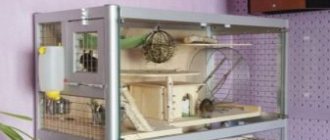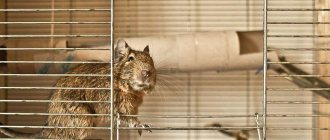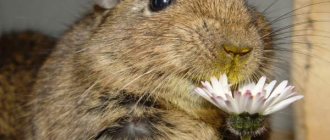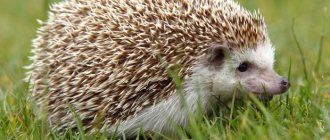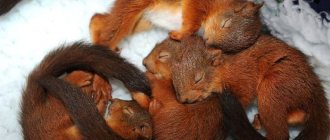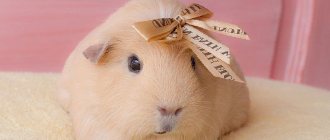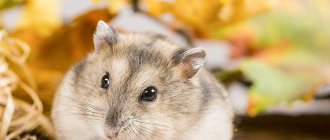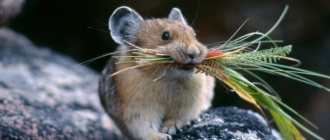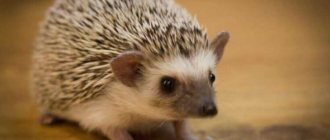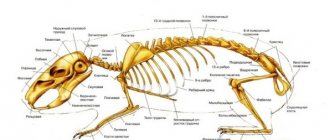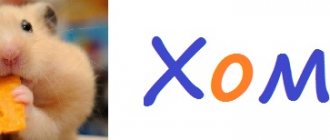One of the main problems in caring for rodents is odor. The owners know that many of their charges choose a specific corner in the cage for the toilet. Therefore, to reduce the aroma, you need to remove wet sawdust once a day and add fresh sawdust.
This will help reduce the harshness of the odor and allow for comprehensive cleaning once every 2 weeks. The choice of degu litter plays a key role in cleanliness. Simple torn pieces of newspaper are not suitable here - as they do not absorb the smell well, and the animal itself can be poisoned by the printing ink.
Therefore, it is better to use special fillers for degu bedding, which are sold in pet stores. They quickly and efficiently absorb the smell of animals and do not harm them.
Degus belong to animals that are underground. As a shelter, they dig trenches for themselves with numerous passages. When keeping degus at home, this fact must be taken into account. It is necessary to make bedding in the cage. Carpet or linoleum is not suitable.
Rodents need to dig. What kind of cage would a degu be comfortable in?
Keeping degus at home
If you decide to make a degu as your pet, then first of all you should take into account that these animals do not get along well with other animals. Therefore, it is better to take them into the family as your only favorites. In order to avoid problems with keeping a degu, you must initially choose the right pet.
Which animal should I buy?
Degus are not yet very common in pet stores, so you can purchase this pet mainly from breeders or in a nursery. They are also sometimes sold at the Bird Market, but this is one of the least reliable places to purchase an animal, since sellers often do not provide complete information about its health.
When buying a degu you need to pay attention to several basic parameters
- The age of the animal is from one and a half months and older.
- Clean, shiny eyes, no sticky eyelashes.
- The two yellow upper incisors should be visible without any damage.
- Shiny, tightly lying coat with no signs of loss.
- The animal should behave actively, but treat the outstretched hand with tension.
- There should be a fluffy tassel at the end of the tail.
- The cost of degu is from 500 rubles and above. You should not chase a low price, as it usually hides some shortcomings.
If the animal does not meet these signs, then it is most likely sick. And treating degus is expensive, so it’s better to abandon this option and look for a more suitable one.
Degu cage
In order for your new pet to live in comfort and safety, he needs his own home. The cage for the Chilean squirrel should be spacious, preferably multi-story. Stairs and various passages will make the home almost ideal. It is advisable to use metal as a material for the cage, since wood and plastic will easily yield to the teeth of a rodent.
Like almost any pet, degus need to play and have fun. For this purpose, the cage must have appropriate devices. Houses, ropes, shelves at different levels, a running wheel and a hammock will make your pet's life rich and active. But the best thing, of course, is a second similar squirrel for games.
Degus also need a place for hygiene procedures. These animals are never washed with water; they use special zeolite sand to clean their fur. A container with this sand must be placed in the cage every day, and after completing hygiene procedures, it must be removed, otherwise the degu will begin to use it as a toilet.
Daily regime
Degus sleep at night and are awake during the day. In the morning and evening, the animals can be released to walk around the room. This will bring pleasure to both the squirrels themselves and their owners, since at such moments they can play with their pets. The rest of the day, the kids will have fun in the cage on their own, stopping for food and other necessary procedures.
What to feed your degu squirrel
One of the main parameters of quality housing is proper feeding. Animals need to be given plant foods:
- hay;
- grass;
- corn;
- roots;
- special pellets;
- fruits;
- nuts.
For feeding, you can purchase ready-made mixtures for degus or chinchillas at pet stores. But if you have the time and desire, you can prepare food for your pets yourself. Typically, this food consists of a mixture of oatmeal with dry peas and various grains. But good hay is best suited for food, which should be constantly present in the feeder. You can also let squirrels chew on different branches, but not from stone fruit trees: cherry, apricot, plum.
Degus have quite sensitive digestion, so their diet must be carefully controlled. You should not give the entire daily diet at once, it should be divided into 4-5 servings. In addition to the main diet, degus should eat greens, vegetables and unsweetened fruits daily.
The body of Chilean squirrels is not adapted to break down sugar, so these little ones have a serious tendency to diabetes. Some foods should absolutely not be given to them, otherwise there is a high risk of developing this disease:
- sweet and overripe fruits;
- any treats containing sugar;
- milk and any fermented milk products;
- food from the human table;
- meat and fish.
It is also better to keep indoor flowers away from these rodents. Some plants are very poisonous to them, for example, Dieffenbachia, Sansiviera, indoor calla lily, palm lily, aralia, stringworm and many others. Degus are very inquisitive and gluttonous; given the opportunity, they will not miss the chance to taste greens. But such a tiny piece is enough to result in the most tragic outcome.
General design requirements
The Chilean squirrel loves space, so its home should be spacious. Animals are very active, constantly on the move. Animals will not be able to show their activity within 4 walls, so they increase the area by adding shelves.
It is recommended to choose a multi-tiered cage with 2-4 shelves. To make cleaning easier, a tray is provided. What are the basic cage requirements for a degu squirrel:
optimal size for a pair of rodents: length 1.2 m, width 0.6 m, height 1 m. For a larger number of animals, a more spacious cage is needed; Plastic and wooden parts should be avoided. The material is easily susceptible to degu teeth. Plastic, fiberboard or MDF are harmful to the health of any animal; the cage should be made of metal mesh. The optimal distance between the rods is 1 cm. If the cage contains a female with puppies, then the distance is reduced to 0.5 cm; the rods must be strong. A degu squirrel can easily cope with a mesh made of thin twigs; Chilean squirrels live in burrows. They love to dig. This is inherent in them by nature. In order for them to successfully realize their instinct, it is necessary to choose a durable pallet. It is made of aluminum sheet and plexiglass. It is possible to adapt a plastic box, but all protruding parts must be covered with aluminum tape
The rodent will not be able to grasp a smooth surface; You also need to pay attention to the door lock. The degu will learn to open a simple latch. Animals are very smart and learn quickly
It is recommended to use a carabiner as a lock.
Animals are very smart and learn quickly. It is recommended to use a carabiner as a lock.
For degus, do not choose a cage for guinea pigs, for rabbits or for chinchillas. Animals are larger than squirrels: they have a larger spacing between bars. The structures are low. Squirrels will not be able to actively run in them. Bird cages are tall, but they won't work either.
They are not wide enough or deep enough. For degus, buy a special cage in the store, make it to order, or build a home for rodents yourself. If indoor space allows, it is better to purchase a display case for degu.
To choose the optimal cell size, adhere to the following indicators. They were compiled by zoologists. At the same time, all useful areas for degus were calculated: floor, shelves, house:
- in a structure with an area of 12,000 - 14,000 cm2, only 2 rodents can be located;
- a structure with an area of 15,000 - 18,000 cm2 is intended for 3 animals;
- 19,000 – 22,000 cm2 – 4 whites;
- 23,000 – 26,000 cm2 – 5 degus;
- 27,000 cm2 – 6 rodents.
The usable area is calculated as follows:
- if the floor length is 1 m, width is 0.5 m, then the area will be 5,000 cm2.
- the cage has a shelf 60 cm long. It is located on the side wall. Its area is 3,000 cm2;
- if the usable area is 8,000 cm2, then this is not enough even for one squirrel. Increase it by installing a new level or shelf;
- a level 1 m long and 50 cm wide gives an area of 5,000 cm2. A hole is made in this panel for the passage of animals, and it is equipped with a ladder;
- The useful area in a two-tier structure with 1 shelf will be 13,000 cm2. A pair of degus can live in such a dwelling.
These calculations must be taken into account when building cells with your own hands. Experts point out some more parameters that must be observed:
- the height of the cage should not exceed 1.2 m for 2 squirrels;
- the distance between tiers or shelves is maintained no more than 35 cm;
- for adults, the distance is increased to 50 cm.
The dimensions of structures for squirrels that are displayed in stores do not always correspond to the standards, so degus breeders often assemble corners for their pets themselves.
What do Chilean squirrels need?
To create comfortable living conditions for squirrels, study the features of their behavior and life in nature. Also follow our advice on the proper care and maintenance of these animals. There are five main aspects to degu protein content.
Living conditions
First, let's talk directly about the content. Remember: degus should live in spacious enclosures. Regardless of whether you have one animal, a pair or several animals, there should be enough space for free movement.
There must be a house in the cage. Under natural conditions, these squirrels live in burrows, so they like to hide in a house or hammock. A thick bedding of hay or special filler is also necessary so that the animal can freely burrow into it.
Make devices for the squirrel to climb. Degus are also called bush squirrels; in their natural habitat they often climb trees; provide them with this need in captivity.
Squirrels need to wear down their claws and teeth, so place a stone in the cage specifically designed for this. You can buy it at a pet store.
Feeding
The diet of the Chilean squirrel is very extensive. They are not picky about food. For the same reason, they may accidentally eat a plant that is poisonous to them. Your task is to eliminate this possibility.
You can feed degus:
- fresh grass: alfalfa, dandelion, green grain crops are best;
- hay: the same plants that animals eat fresh are suitable for hay;
- nuts;
- cereals;
- dried fruits: only unsweetened and in small quantities;
- fresh vegetables and fruits;
- ready food
It is better to buy ready-made food for degu, which is offered by the manufacturer. And also add the necessary vitamins and minerals to it on the advice of a veterinarian. In this case, you do not risk infecting the animal with fleas or worms, which may be contained in hay or grass collected outside.
Care
When it comes to care, health and hygiene are paramount. Animals do not defecate much or often, so it is enough to clean the cage once every 3 weeks. Of course, the frequency depends on the individual behavior of the animal, as well as on the number of residents in one house
Of course, the frequency depends on the individual behavior of the animal, as well as on the number of residents in one house
Animals do not defecate much or often, so it is enough to clean the cage once every 3 weeks. Of course, the frequency depends on the individual behavior of the animal, as well as on the number of residents in one house.
Chilean squirrels love to swim, they do it in the sand. To do this, place a container filled with sand in the cage. You can also take the animal outside the cage every day or every two days and bathe it in a jar of sand or a special container. But, of course, it is better to install such a bath directly in the cage so that the animal can bathe at any time convenient for it.
Carefully monitor the health of the animal. In autumn and spring, add vitamins to your food. In autumn and winter, monitor changes in the animal's well-being, because at this time they may suffer from colds. Do not forget that these animals are susceptible to diabetes, so control the amount of sweet fruits and berries in their diet.
It is worth taking your pet to the veterinarian for examination periodically. Especially if he begins to scream frequently and continuously (which occurs when keeping an animal) or behaves unusually.
Need for communication
In nature, degus live in packs and often communicate with relatives, so the need for communication among squirrels is quite high. They constantly require attention from the owner.
Breeders advise purchasing a relative so that the degu does not get bored. Most often, these animals are bought in pairs at once. Usually same-sex individuals are taken to avoid reproduction. The gender definitely needs to be checked, as there are many cases where people of the same sex are bought, but in the end they turn out to be of different sexes. To avoid mistakes, it is better to purchase a degu at the age of 1.5 months.
If you don’t want to buy two animals at once, satisfy his need for communication yourself. Degus are highly trainable and get used to their owner.
Show care, patience and attention to your pet, and you will definitely be able to become friends with him
But do not forget that degus cannot tolerate other animals. Therefore, it is better to refuse attempts to make friends with a pet dog or cat. Breeders advise against getting a degu if you already have animals in the house. The animal may develop allergies or be exposed to a stressful situation due to contact with a dog or cat, which will negatively affect the degu's health.
Read with this
Cage requirements for Syrian hamsters
Cell dimensions
Although the hamster is a small animal, space is also important for him. The dimensions of the bottom of the cage should be from 30x50 cm, even if the cage has 2 or more floors. Minimum height: 25 centimeters and above; if this is a cage with floors, then the height between them should be approximately 0.3 m.
The dimensions of the door should allow the owner to easily reach the pet, and the gaps between the door and the cage should not allow the hamster to get out.
The distance between the rods should be within 0.5–1 cm.
Entertainment
It is recommended to put toys in the cage so that the animal can keep itself busy playing and not get bored. Hamsters need toys not only for entertainment, but also for grinding their teeth. You can buy them at a pet store, or you can use improvised materials. Hamsters love to play with toilet paper rolls and cardboard. It is necessary to ensure that there are no images on them, since paint is harmful to the digestion of rodents.
Litter
The most common filler for bedding is wood sawdust. They should not be very small, otherwise they will get into the animal’s nose or get tangled in its fur. Wood pellets should have no odor and be fairly dense.
Cellulose litter is suitable for hamsters who are allergic to wood dust. It is smaller and lighter than wood.
In addition, it is recommended not to use cat litter containing clay, as it will stick to your pet's paws when wet. Some mineral litters are toxic to hamsters.
Drinkers and feeders for the Syrian hamster
Drinkers and feeders
It is better to choose feeders and drinkers that are attached to the bars of the cage, because Syrian hamsters often turn over everything in the cage.
The best drinker option is a nipple drinker. A hamster can easily turn over a simple bowl, and he can throw filler into the inside of a bird drink like a bird's bowl. With a nipple drinker such problems will definitely not arise.
Houses
The cage must have a place for the small animal to sleep and have privacy. They use such a house to hide from prying eyes, sleep, and here they can hide their supplies.
A dwelling made of cardboard or wicker will be quickly chewed by a pet. A good choice is an economical and practical plastic option. It is also worth considering that the size of the house should allow not only to accommodate the pet itself, but also to set up a nest there and store its supplies. An option with a removable roof is convenient for cleaning.
Where should the cage be?
First of all, the cage should be located where the animal feels comfortable. If there are other pets in the house, then the furry baby’s home should be located so that other animals cannot harm him. In addition, the cage should be placed where the hamster will not be disturbed by sounds or lights, especially during daytime naps.
Is a running wheel a must-have?
Running wheel
Since Syrian hamsters are hyperactive creatures, they simply need a running wheel. The diameter of this wheel should be at least 18 cm, and optimally 23 centimeters. It is best to choose a wheel with a mesh surface, since a mesh surface can damage the foot. The mesh should be fine enough not to cause injury.
Mineral stone
Mineral stone is necessary for grinding teeth. In addition, it is a source of elements useful for a small pet.
There are mineral stones that can be attached directly to the rods, which is very convenient. Instead of mineral stone, you can give your furry friend small branches of fruit trees.
Do you prefer stone or branches? Poll Options are limited because JavaScript is disabled in your browser.
Toilet
Usually the toilet is placed in the corner of the cage, as far as possible from the food bowl. The toilet is a tray with filler.
The tray should be spacious. As a rule, they take a rectangular or triangular toilet 15 - 18 cm long.
DIY housing for a hamster
Degu in the wild
Chilean squirrels are social animals, as they live in small groups, which include no more than 2 males, about 5 females, and a dozen cubs. Each such family occupies an area of about 200 square meters. Habitats are characterized by the presence of a food supply, as well as a network of underground tunnels. Each family makes sure that strangers do not appear on their territory.
Lifestyle
Living in natural conditions in groups, the animals do an excellent job of digging holes, as well as maintaining them. When digging holes, the animals line up in a chain, after which they pass the land to each other. This way the soil appears on the surface. This method of digging holes allows animals to create fairly long tunnels underground.
This animal spends quite a lot of time underground, while the animals constantly feed and make provisions for the winter. Reserves are made either in burrows or buried in the upper layers of the soil. The basis of the diet of such animals is:
- Various herbaceous plants.
- Tree bark.
- Green leaves.
- Seeds of various origins.
- In winter, dry herbs and leaves.
As a rule, a female becomes pregnant once a year, although there are cases where she becomes pregnant twice. Pregnancy lasts almost 3 months, after which from 1 to 10 cubs are born, weighing no more than 15 grams each. While in captivity, a female can become pregnant several times. Since the female can become pregnant again after giving birth, it is better to remove the male immediately.
For 2-6 weeks, the offspring mainly feed on mother's milk, but after 2 weeks solid food begins to appear in their diet. After 3 weeks, the small animals begin to leave the hole on their own.
If the young try to leave the shelter early, the parents drag it back into the hole. Males do not stand aside and help females raise their cubs. They constantly carry fresh grass into the hole. Before the onset of sexual maturity, the young animals form same-sex groups, and after 4 months the young animals are able to mate.
This animal is mainly diurnal, with the greatest activity occurring in the morning and evening.
Natural habitats
Since this is a South American rodent, it lives in countries such as Peru, Argentina, Bolivia and Chile. Its favorite places are rocky areas, abundantly overgrown with shrubby vegetation.
These animals try to avoid direct sunlight, so during particularly hot periods they prefer to stay in their shelters.
To feed, Chilean squirrels appear on the surface of the ground early in the morning or late in the evening, when the sun's rays are not so active. In addition to the heat, these animals are afraid of falling into the clutches of their natural enemies, and there are many of them.
These rodents often appear in fields, causing damage to agricultural crops, and are therefore considered pests of cultivated plants. Eating plants in the fields, animals often die, poisoned by various chemicals.
Life with Degus/Pros and Cons/We have a new addition
Watch this video on YouTube
How to build a house for a squirrel with your own hands from wood
This little rodent has its own character. In America, local farmers do not like these animals, as they are capable of destroying grain and corn. There they adapted to live in completely unusual conditions - they can be seen in cardboard boxes, abandoned attics, and plastic containers.
Domestic forest beauties prefer a more comfortable home. The most suitable construction option is a two-story squirrel house with an internal partition.
1 option
To build a simple and comfortable house for a squirrel, you need an edged board 30 cm wide and 1.8 cm thick. Next, you need to perform the following work:
- Select a 55 cm board and saw it off. This will be its back wall, its dimensions are 55x30 cm.
- Mark 5 cm at the bottom and top of the back wall. These are the parts for which the house will be attached to the tree.
- The side walls are cut out. Two pieces 45x25 cm come out of them.
- For the internal partition, cut out a piece 20x25 cm.
- The lid should have the following parameters: 30x30 cm, bottom - 25x30 cm.
- To make a porch, take two planks.
- On the top left side of the facade, make a hole for the entrance, the diameter of which is 7–8 cm.
When all the details of the future mansion are ready, you can begin the assembly itself. Each part must be sanded, as even small cuts are dangerous for squirrels. After making sure that the glue does not have any strong or persistent odors, all parts must be assembled onto it. When in perfect order, all this is fixed with self-tapping screws.
Option 2
It will be more comfortable and convenient for squirrels to live in a built log house. It reminds them of a natural home. And they settle in it with pleasure. The design of such housing is similar to natural decor. The assembly design is simple.
First, a log is sawed, the diameter of which is 40 cm, and the walls are 3 cm. The inner surface needs to be processed - sanded. Then the inlet hole is sawed through and the cover is nailed. The finished house can be safely attached to a tree.
Video on how to make a house for a squirrel with your own hands:
Origin and description of the species - all about degu
Degus live in the territories of several countries: Bolivia, Peru, Argentina. But the highest population density of these rodents is observed in Chile, where they inhabit the entire western part of the Andean Cordillera.
Local farmers have long known the harmful animal, which eats crops, raids food granaries and causes significant damage to agriculture.
In the scientific classification, degus belong to the eight-toothed family, which unites 13 species of rodents. But the Chilean squirrel has its own distinctive features:
- degu in nature goes out for food during the day, while other representatives of this family do this at night or at dusk;
- all feed exclusively on tubers, young shoots or bark, and degu prefers to look for prey in the thickets of cultivated plantings;
- Most eight-toothed squirrels dig extensive underground labyrinths, but the bush squirrel is not very successful at this.
How long do ferrets live at home?
Note that in the wild, domestic representatives of this species will not survive at all. Such animals are simply not adapted to exist in the steppe. How long do ferrets live at home? With proper care and a balanced diet, their life expectancy is 10 years. Although some representatives lived to be 15-18. This is how long domestic ferrets live. There are factors that can reduce the lifespan of an animal by five to six years. These include acquired or hereditary incurable diseases.
But we can say with confidence that keeping animals at home does not shorten the lifespan of animals. Now you know how long ferrets live at home. Of course, all the data given above are statistical averages. Therefore, a lot depends on conditions and nutrition.
We figured out how long a ferret lives. Now we need to highlight the main conditions for the long life of this beast. A lot here depends on nutrition. It should be as balanced as possible. You should always remember about the individual characteristics of your pet. When giving any new product, it is necessary to observe the animal’s reaction. Note that ferrets eat almost everything, but do not forget that they are predators. Therefore, the basis of the diet is meat. You can give these animals beef, offal, chicken, and horse meat. Some types of fish are also allowed, of course, without bones.
If you do not give your pet meat for a long time, then as a result his immunity will decrease, the digestive system will also be disrupted, and it is possible that his hair will fall out.
You can supplement your diet with special vitamin and mineral complexes. You should definitely consult a veterinarian about this. Of course, hygiene also affects the life expectancy of a pet. Ferrets love cleanliness and order. Their cage needs to be cleaned daily, rags and bedding changed. The home should always be warm and, of course, dry. Bowls and drinking bowls must be washed daily.
Bathhouse.
— Degus are very active animals that need large and spacious cages.
Since they do not live in trees, the area, not the height of the home, is important to them. — When choosing a home for a degu, we are guided by scientific research, and not by the approximate volume and size of the cage. (Proper Cage Sizes for Degus) - Wooden cages and accessories should be made from suitable materials and tree species. Share your work with other winemakers and they will thank you! — Any plastic products are prohibited for use in degu homes. They are very harmful. — All shelves and ladders should NOT be made of bare wire. — The diameter of the running wheel must be at least 28 cm. We do not recommend using walking balls. What kind of baths do you have? Show me the photo. It's interesting!
Bathing suit for chinchillas, too lazy to look for a photo) but it is present in the video about sand. from https://www.youtube.com/watch?v=SBPfDaIMHqA&list=PL69FBB3A1CA27A4DA&index=4
I bathe about 3 times a week, put the bathing suit in the window for 15 minutes, and then put it away.
Actions define a person, not words.
Ours bathes every evening, we set the bath for 15-20 minutes.
Yesterday I bought a new bath and hung it in a cage. Before this, the bathhouse stood in an old small cage, where there was a free entrance and exit. Therefore, Chirik and Ponytail went to wash themselves as needed. There were no fights for sand or space. The new bathhouse is closed, but the old one was just a carrier with sand. And when the degus began to splash, that’s it, turn out the lights: dust, sand in all directions! And when they leave (even from a new one), “sand pours out” behind them. It will hold it together near the cage. For now, the new one is permanently installed, but I’m thinking about installing it for a while. I'll see over the weekend how often they dive there. Photos will be up on Monday morning.
Do your degus swim in “dirty” sand? I've noticed this kind of pickiness. I’ll set up a bathhouse, Fenya will come in and sniff, if the cleanliness of the sand suits her, then she bathes in it, but if the sand is already very littered (poop, sawdust, blades of grass, etc.), she disgustedly goes out and doesn’t even bathe in it.
How often do you change sand?
You can contact me using “YOU”.
Because of this, I keep looking at store-bought indoor bathing suits so that less garbage gets into the sand, but I am confused by the fact that they are plastic. I think they will gnaw. I didn’t see any others in the store, there was only one option with no choice.
You can contact me using “YOU”.
I try to keep the sand clean. I pick out the trash. And as I use it up I add more sand. Once, when the sand was already dirty for swimming, but it was a pity to throw it away, I decided to pour it on the floor of the cage. And I regretted it. The degus raised a terrible swarm. Dust hung in a column above the cage. But I really count on the degus to be conscientious about the frequency of bathing. Of course, if they sit there on a permanent basis, the bath will quickly become combined with a toilet. Therefore, for now I will monitor the question of whether the bathing suit is permanently or temporarily in the cage.
Because of this, I keep looking at store-bought indoor bathing suits so that less garbage gets into the sand, but I am confused by the fact that they are plastic. I think they will gnaw. I didn’t see any others in the store, there was only one option with no choice.
At first I wanted to buy it, but I adapted a glass jar for cereals. It is convenient to place it on its side. I removed it from the cage and they set up a trash bin there. I put this jar on my walks, they run there themselves. And when they crawl out, the sand wakes up, and the next time, running past, the degus drive through the sand with their bellies, like seals on ice! And then back inside. I don’t change the sand often, I just choose the excess. I add more sleep if it’s not enough.
Veselukha is on your walks. I feel like there's a real show going on.
You can contact me using “YOU”.
Double. What's wrong with the site today?
And, most importantly, there is no way to delete an unnecessary message.
You can contact me using “YOU”.
Everything is fine with the site, I didn’t have any glitches, no one else complained, maybe there’s something wrong with your Internet. You can now delete your own topics. Please discuss problems and their solutions in the appropriate forum topic.
Actions define a person, not words.
Alexander, tell us how the test drive of your suspended swimsuit goes? Very interesting. Are you happy with her? Are they chewing on the entrance? Or is it a special “indestructible” plastic?
You can contact me using “YOU”.
While I'm waiting for an answer from Alexander, I'll tell you how we had fun on Saturday.
All experiments were carried out on Fenya. Although it should have been over Sonya, because she has a better relationship with bathing, Sonya slept peacefully and did not suspect that insidious plans were being hatched against her.
PS I took a photo for clarity. At that time, I had already poured out the sand and washed the jar.
You can contact me using “YOU”.
Overall, I'm pleased with the test drive. On Friday evening I came and saw complete chaos in the bathing suit, which was expressed in many “what”. But I removed them. There was no debris in the sand, so overall everything was fine. According to observations over the weekend, degus climb into the bathing suit when necessary. In their opinion, this includes cases of pollution. For example, in the evening I used hand cream and smeared some cold sore on my lip with ylang-ylang oil (which was on hand), then took Chirik in my arms. Degus was categorically not happy and, having escaped, immediately rushed to swim. Because they got dirty! They don't go to the bathing tub out of boredom. Or rather, wandering around the cage, they are puzzled, stand on their paws and think: should I quit or not? Tail sometimes also hides a nut there. I wrote about this in the Tea Degus diary today. As well okay. The sand doesn’t fly, it’s not very convenient for them to chew: firstly, the bathing suit hangs, and secondly, there’s nothing special for the tooth to grab onto. This is something like the case with the jar in the photo. Well, the aesthetics are small, which is also nice.
Advantages of keeping a rodent at home
Advantages of the Chilean squirrel as a pet:
Small dimensions. You don't need a lot of space for a degu. Modesty in nutrition. Decorative animals require less food and water than guinea pigs. High activity
Curious and energetic degus will not let you get bored and will become favorites of children who are careful when dealing with rodents. The biological rhythms of the pet and its owners will coincide.
Easy to learn
The animals quickly become attached to humans and are easy to train. Cleanliness and absence of unpleasant odor. Degus clean themselves and do not require special hygienic care from others. Due to the small volume of food and drink, the animals produce little excretion. Cleaning the cage is done quickly. Lifespan. This indicator for the South American guest is higher in comparison with hamsters, chinchillas and other relatives.
Attention! If degus have offspring, the animals will not need any additional care or equipment.
Purpose and size
When determining the dimensions of the cage, they are based on the type and size of the pet, as well as the number of individuals (when housing several rodents). The rodent's home must be spacious enough, otherwise the animal will be aggressive and constantly experience stress. Cramped conditions force the animal to lead a sedentary lifestyle, which leads to obesity.
The choice of cage size is influenced by the presence or absence of a feeder, drinking bowl, running wheel and other accessories. If you plan to buy additional items, you need to provide space for them.
A cage that is too large takes up a lot of space in the room, which is not always convenient. For some rodents, large multi-story (2-4 tiers) houses are dangerous due to the risk of injury when falling from a height. Therefore, there are minimum cage sizes per pet, excluding those that do not live alone (gerbils, degus).
For rabbits - one-story metal models or cages made of wood and metal with a plastic tray.
Cage dimensions (length, width/depth, height):
- 70x40x35 cm (mini-breed rabbits);
- 90x60x45 cm (dwarf rams);
- 100x80x70 cm (large domestic rabbits).
For guinea pigs - single-story cages made of metal, plastic or a combination of these materials. Such models are equipped with a plastic tray with high sides (up to 18 cm) to protect the animal from drafts. This design feature prevents the animal from scattering garbage. Cage dimensions: 60x40x30 cm.
For hamsters - single-story metal, plastic or glass cages. The tray must be made of plastic.
Cage dimensions:
- 50x30x30 cm (dwarf hamsters);
- 60x40x40 cm (golden and Syrian hamsters).
For mice and rats - multi-storey cages made of metal and equipped with a plastic tray.
Cage dimensions:
- 25x15x15 cm (dwarf and white mice);
- 50x30x30 cm (rats).
Important: for a hamster, mouse or rat, it is recommended to choose a cage with horizontal bars so that the animal can climb on them. For gerbils - one- or two-story models, which are made of metal or a combination of glass and metal
The pallet is metal. Cage dimensions: 70x50x25 cm (pair of gerbils)
For gerbils - one- or two-story models, which are made of metal or a combination of glass and metal. The pallet is metal. Cage dimensions: 70x50x25 cm (a pair of gerbils).
For chinchillas - multi-story metal, wooden or glass cages. Metal models make a lot of noise when the animal runs through the tiers of its house, and wooden cages absorb moisture and odors, which negatively affects the performance properties of the product. The best choice is glass models. Cage dimensions: 90x70x50 cm.
For ferrets - multi-story metal cages. The plastic tray must be equipped with a mesh bottom to protect against gnawing. Cage dimensions: 80x60x45 cm.
For squirrels - one- or two-story metal cages with a plastic tray. Cage dimensions: 60x50x150 cm.
For degus - multi-story cages made of metal. As with ferret models, the plastic tray has a grid bottom. Cage dimensions: 120x60x100 cm (pair of degus).
For chipmunks - single-story metal cages equipped with a plastic tray. Cage dimensions: 50x40x60 cm.
Why her?
There are many other small animals!
- Because Chilean squirrels are unique. Few exotic animals are capable of learning and training. Degu - can follow simple commands and makes contact easily, unlike other rodents. She will become an excellent friend to the child, while demanding very little in return.
- Degus have an interesting appearance. They look like a mouse, a jerboa and a squirrel at the same time. Its size is small - about 30 cm. But there is more than enough activity in this small body! This cute animal loves to run around and stick its curious nose everywhere, almost purrs when it is petted and carried in arms, and happily responds to communication.
- The most important advantage of the degu is its tendency to diurnal lifestyle. How many rodents can boast of this? With this animal, you won’t have to sleep with a pillow on your head at night; it will sleep with its owner, and not instead of him!
- Chilean squirrels are long-lived, living about seven years with proper care and attention. So they are not suitable for those who want to take a “one-time toy”.
The best sand for degus: top 5
| Name | manufacturer | description | price |
| Little One | Russia | Sand of volcanic origin. The granules are clearly visible. Doesn't get dusty. Hydro and lipophilic properties, as well as viscosity, are well demonstrated. Easily shakes off wool without leaving a dusty effect. | ~ 250 – 300 rub. |
| Waka | Russia | Contains quartz, as stated on the packaging. Not recommended for use. | ~ 100 – 150 rub. |
| Versele-Laga | Belgium | Zeolite sand. The granules are large. Doesn't get dusty. Cleanses the fur and skin of the animal well. | ~ 450 – 550 rub. |
| Super Pet | USA | Sand of volcanic origin. Doesn't get dusty. The granules are medium. Wool does not become dusty. | ~ 550 – 650 rub. |
| Cliffi | Italy | The composition of the sand is not indicated on the packaging. Not recommended for use. | ~ 600 – 700 rub. |
The nuances of feeding a newborn
Squirrels have a longer gestation period than other similar animals, such as rats or hamsters. Therefore, babies develop a little faster. Newborn squirrels look just like their mothers. They already have fur and their eyes are open. In addition, there are teeth almost immediately.
However, at first they move very poorly and only after a week will they be able to try to get out of the nest. The squirrel does an excellent job of feeding its babies. However, you should not pick them up, as she may refuse to feed. Therefore, if you need to take your baby, for example, for an examination, be sure to wash your hands with soap so that the squirrel does not smell the person.
In addition, it may also happen that the squirrel dies during childbirth or shortly after it - then a person must take care of feeding. This can be done using milk mixture heated to +36 degrees. Feeding can be done using regular pipettes or a syringe without a needle. If they are not there, then an ordinary cloth soaked in the milk mixture will come in handy. The mixture can be prepared from cow's milk and chamomile tea. The proportions should be 1 to 2.
The baby squirrels need to be fed every 2-3 hours. After each feeding, be sure to massage their belly. You need to feed the mixture for no more than 30 days, then you can gradually introduce dry food into the diet, for example, hay or grain. In addition, you can also give some nuts, vegetables and fruits.
A 2-month-old baby can eat almost everything. Therefore, they can be transferred from a nest to a cage, to a permanent place of residence. From now on, they begin to live an adult life and, accordingly, eat like that. Some owners give them formula milk for some time, only from a small saucer.
Is there anything I can replace store-bought sand with?
In an effort to save money, some owners decide that they can make bathing sand themselves. Well, except that you have access to volcanic rocks and your own crusher. In all other cases, there is no need to come up with anything extra.
No matter how small it may be. It's all about the physical properties of the material. This sand does not absorb liquid and fat from the coat, it injures the skin, and if it gets into the eyes, it clogs and injures them.
Do not replace store-bought sand
It is also recommended to add talc; by the way, some manufacturers either add it to ready-made sand or include it in the package. Talcum powder cannot be used.
Not only will a cloud of talc settle on all surfaces, but it is also dangerous because it clogs the animal’s fur, lungs and eyes. The sensations are not pleasant and may lead to refusal of bathing.
Is it worth getting a degu?
The Chilean squirrel is a rather unusual animal. This is not a hamster that feels comfortable sitting alone in a cage for days on end. They are very active and require a lot of attention. Before purchasing, you should study all the details of keeping a domestic squirrel and know what to prepare for.
Degus have become favorite pets for many owners, because there are many advantages to keeping them.
- They eat quite a bit, so you won’t have to buy a lot of food, and for this reason they defecate less often, so the cage will have to be cleaned infrequently.
- They drink little, therefore, urinate less often, which also helps keep the cage clean for a long time.
- They are friendly, get used to being handled and are easy to train.
- They lead a diurnal lifestyle.
- Their life expectancy is quite long - 812 years.
Cons of content
With all the advantages, there are also disadvantages.
- They are very active, love to move a lot, but at the same time you can’t let them roam freely around the house, they can chew on almost anything.
- They often suffer from colds, indigestion, may even develop diabetes, and are prone to allergies. Be prepared to care for a sick animal.
- They do not like loneliness and require attention, as in nature they live in packs. If you leave a degu alone for a long time, it can become unaccustomed to being handled and even go wild.
To ensure that the animal brings only positive emotions, and its life is comfortable for you, weigh the pros and cons before going to the pet store. Before buying an animal, be sure to answer whether you are ready:
- 7-12 years old to care for a pet?
- treat him and take him to the vet if necessary?
- devote time every day and train the animal?
- feed correctly?
- clean the cage in a timely manner?
- allocate additional funds for maintenance?
We suggest you read: What to feed a Caucasian Shepherd puppy
Ask yourself if you are ready to take full responsibility for the animal’s life. If the decision is balanced and informed, feel free to go shopping.
Cell
Degus require a lot of space. Choose the largest cage with a hard bottom and place it in a dry, draft-free room away from direct sunlight. The height of the house is as important as the length and width. Degu loves to climb. If the cage has different levels, the shelves should be covered with untreated wood so that the degu does not injure its legs. Cover the floor with specialty bedding such as aspen or pine shavings, recycled paper or corncob bedding. Do not use cedar shavings, which contain harmful oils.
You can purchase or make a degu house like a birdhouse, that is, a box made of untreated wood or an old cardboard box that your pets will happily chew on. It is better to offer degu food in a ceramic bowl and fresh water in a bottle.
Degus need a lot of exercise and stimulation, so it is important to provide them with a variety of toys. A large exercise wheel is a great choice.
Many degus like metal wheels with crossbars, but you need to carefully monitor your pet to make sure that he does not injure his legs. The branches of a maple or fruit tree will help you to climb to the height of the degu pleasantly and comfortably. A large, deep box filled with soft, sandy soil provides a place to dig.
Cardboard or wood is a favorite material that degus love to chew; by the way, this is what helps them keep their teeth in shape and grind them down correctly.
Keep your degu's habitat clean by removing dirt and debris daily.
Once a day, you should thoroughly clean your glass or plastic water bottle. You need to wash the dishes and the bottom of the cage once a week. After rinsing the cage, it needs to be completely dry before adding shavings to the bottom.
Content Features
Keeping any exotic animal has its own subtleties and nuances. Below are some useful tips and tricks for keeping degus:
- Before getting a squirrel, ask your veterinarian for detailed information about vaccinations and possible diseases;
- carry out deworming with special preparations once a quarter;
- if a rodent’s hair begins to fall out, its eyes become lighter, and lethargy appears, then this is a sure sign of an illness that requires emergency care;
- There must be hard twigs or sharpening stones in the cage. If they are absent, this will lead to discomfort and deformation of the jaw;
- When letting your squirrel go for a walk, you should monitor its movements. It is best to buy a special walking ball at a pet store, then the rodent will not be able to harm your furniture and electrical wires;
- Degus are amazing rodents. They sleep all night and begin active life only in the morning and daytime hours. This rodent is ideal for owners of small apartments;
- The lifespan of bush rodents is 8 years in captivity. And after reaching five years, they stop reproducing.
If you dare to get a bush squirrel, you will not regret it. They are unpretentious, smart, and most importantly, they do not have an unpleasant odor. Degus will make wonderful friends for families with children. They get along well with all residents of the house and pets.
Authors of the articles: Belanta Clinic team
What types of trees are safe for my degu?
Safe types of wood for degus: apple, hazel, hawthorn and pine (but only after kiln drying). Before you give such a tree to a degu, bringing it from the street, you must clean it. To do this, you can use a wire brush or water. Make sure that the wood has not been treated with chemicals before. Also pay attention to the presence of fungus, mold, insects and other things. Use the list of suitable types of wood for degus (link at the beginning of the article), as some types of trees can be harmful or even toxic to degus.
Games, taming degus
Degus have an excellent memory, so constant contact is the best investment in the process of successful training of the animal.
And the greatest care from beginning to end is the driving lever. Young immature individuals are best trained
No, their age does not affect their mental abilities or the degree of receptivity of commands. It’s just that as degus age, they have less trust in humans.
It is important to provide suitable terrain before training begins. This could be a room with no hidden nooks and crannies where the animal could hide or escape.
Also avoid open electrical wires, which he can chew and harm himself and the room. The first step is to start talking to him. The quiet, gentle voice of the owner will soon become recognizable to the degu
Hand feeding is also important for bonding. Before starting, it is important to wash your hands so that they do not smell like food, so that the animal does not confuse your finger with a delicious pear
Food can also provide motivation to perform tricks. For example, you can lure a degu with a piece of treat onto your shoulder, repeating the trick every day.
Never take it from above. In the wild, these animals are subject to attacks from birds of prey and animals from above; in such a situation, a frightened degu may use self-defense and begin to bite.
The Chilean degu squirrel should walk around you unhindered; you should not pick it up with your hands, squeeze it, or drag it anywhere. Freedom is an important aspect of trust. Degus love to have the back of their head tickled, but persistent and prolonged tickling can cause them to run away or even bite you.
For more productive communication, it is important to understand the “degu language”. For example, if his hair stands on end, he is alarmed and feels threatened
During breeding or when the animal is in an excited mood, it wags its tail. Jumping, running, leaping and twisting the body are characteristic of healthy, active, happy degus. This behavior is often observed in young animals. Degus huddled together crave a sense of security. They can often sleep in one big, furry pile. Squeaking is typical for nervous, irritated behavior, growling is for aggression during an approaching threat. If the squeak is more like heather, it is simple communication or the courtship cries of lovers.
Despite the irresistible desire to devote all your time to an animal, it is unlikely that anyone will succeed. Degus are social animals; living alone without company and attention, they can become apathetic, withdrawn, aggressive and even lose their health. Buy a pair for your pet, or even better, place them in a cage in the amount of 4-5 individuals.
Reproduction and offspring
Chilean degu squirrels reproduce wonderfully both in the wild and in home breeding conditions. Although the newlyweds and their offspring will have to be shown special care. It is important to prepare the cage. Remove the wheel and shelves from it. This will protect the pregnant female from injury, and subsequently her babies. The relationship between the intended parents should be cordial. Degus should not be afraid of each other or show aggression. When taking a pet from outside to produce offspring, place it in a cage with a female for a while to get used to it. Both animals must be healthy and not related.
Squirrels are considered sexually mature after 50 days of age. The gestation period of a female degu is 90 days, give or take. Moreover, by day 40 this already becomes noticeable. One litter can consist of from 1 to 11 squirrels. A healthy pregnancy should not be repeated more than after 360 days. Babies are born fully formed, their body is already covered with soft fur.
Return to content
Health, disease and prevention
A healthy degu pet is sociable and active. An important indicator of health is clean eyes, without visible foreign stains. Also, orange teeth, if they have begun to lighten, are a reason to adjust the Chilean squirrel’s diet. Even with poor nutrition (an abundance of fiber-rich vegetables and fruits on the menu), the animal may develop diarrhea.
The most common ailments of degus:
- Conjunctivitis. Characterized by the presence of purulent discharge from the eye area. Antibiotic drops are used for treatment as prescribed by a veterinarian.
- Older degu squirrels can suffer from cataracts. The appearance of a white spot on the brown background of a healthy eye is the first sign of the disease.
- Diabetes. A common ailment of improper feeding. Manifests itself in weight gain, lethargy, and increased water consumption. There is no cure for diabetes, but there are preventative measures to prevent its development. Candies, halva and other sweets are unacceptable foods for degus under any circumstances. If the first symptoms are noticed, limit the animal’s consumption of nuts, high-calorie cereals and overripe fruits.
- Colds can also bother the naturally heat-loving degu. The special “enemies” of the health of this furry animal are sudden temperature changes and drafts. If the animal's eyes begin to water, mucus appears near the nose, and apathy is a sure sign that the squirrel is sick. At an early stage, it is treated with traditional methods - a decoction of rose hips and calendula. If it does not help, you need to contact a veterinary clinic.
- Also, contact with sick animals and insufficient cleanliness in the cage can provoke the appearance of skin fungus or parasites.
The main preventive measures are regular cage hygiene and balanced feeding. These are the two “pillars” that will help you avoid all the ailments of your home degu.
How to choose quality sand?
When choosing sand for degus, you should give preference to the most well-known manufacturers. It is necessary to carefully study the composition. There should be no presence of river or quartz sand. Ideally, volcanic dust. Of course, you shouldn’t rely on the veracity of the information, so you can do a small test before offering it to your pet.
First, take a small amount of sand and carefully examine it in the light. The presence of shine will indicate that the composition contains quartz. Quartz is very sharp and can injure the delicate skin of the animal. The sand should be matte.
Photo of a degu bathing
The next step is to rub it in your palms. There should be no feeling of scratching or roughness. But associations with flour on the palms or powder are a good sign.
Now comes the hydrophilicity test. The sand needs to be slightly wetted and formed into a ball. The fact is that volcanic dust, from which good sand for degus is made, contains clay. It is this that imparts viscosity and stickiness to the material. The resulting ball must be left to dry. After drying, the lump should remain hard and strong.
But river or quartz inclusions will make the ball brittle, and it will easily fall apart. Well, the simplest and most effective way is to take a little sand in your mouth. If it dissolves, good. There is a residue left - bad. The method is strange, but absolutely harmless to humans.
